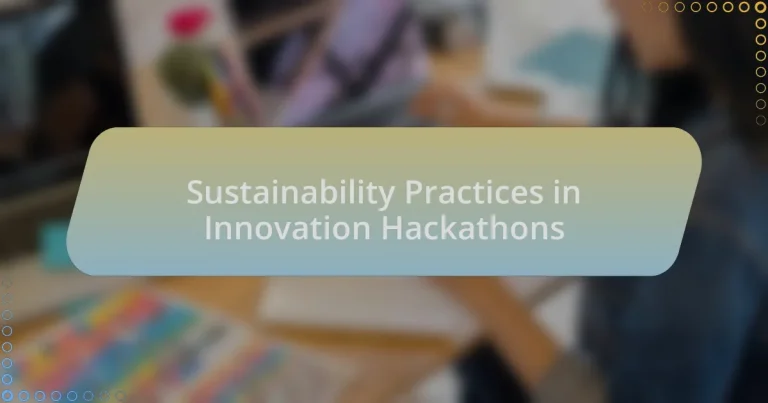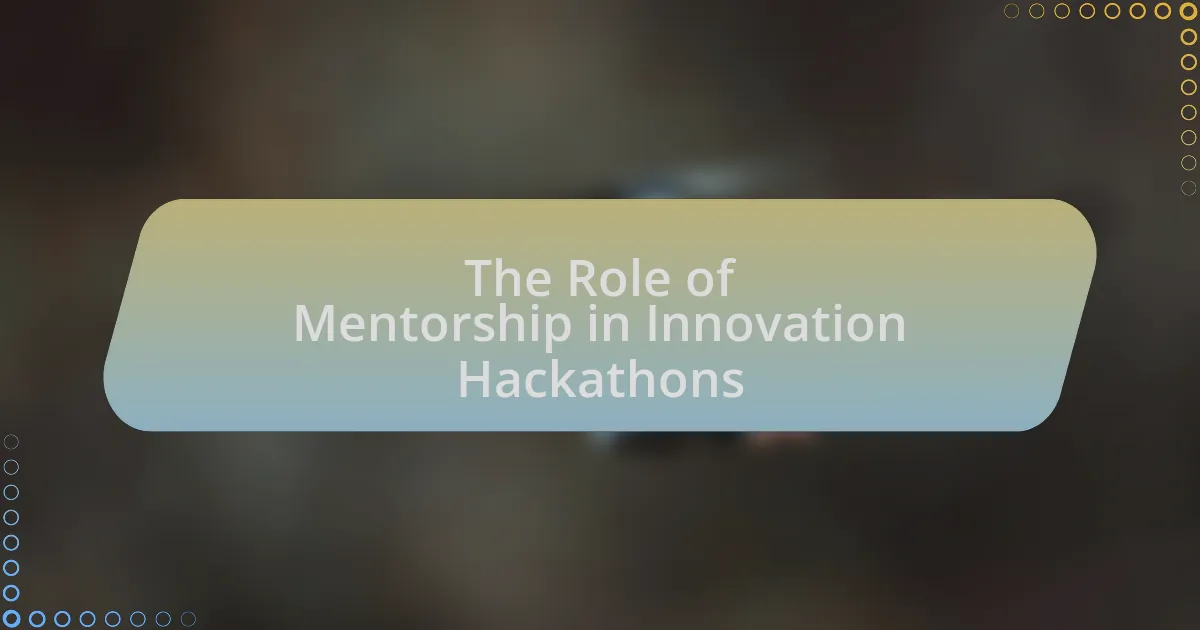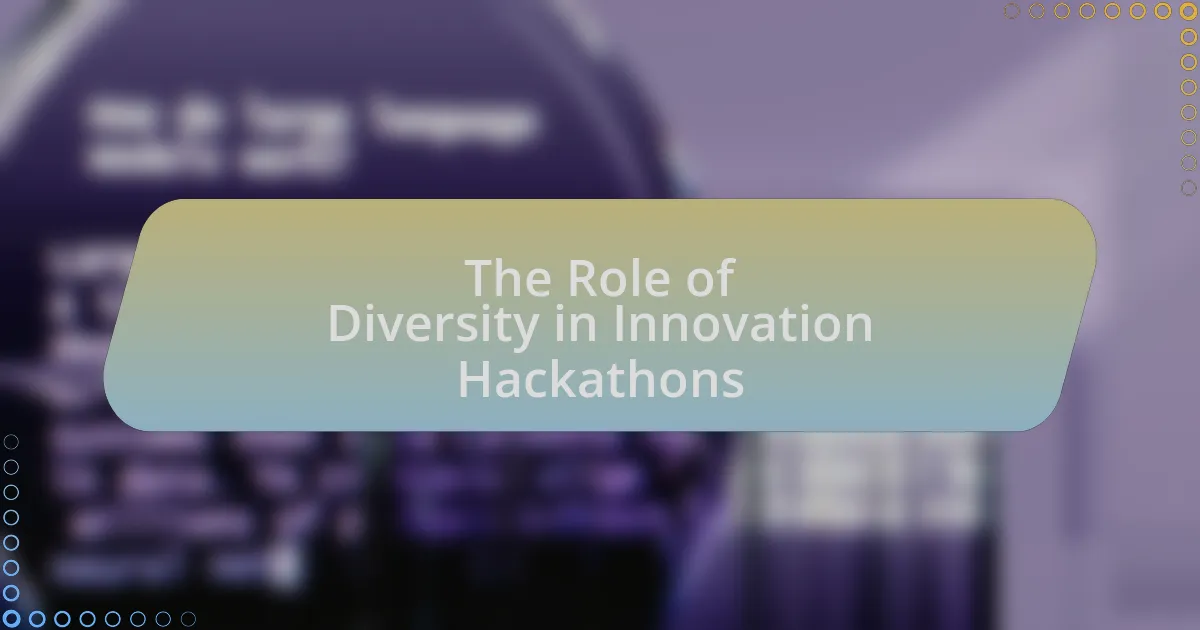Sustainability practices in innovation hackathons focus on minimizing environmental impact and promoting social responsibility during these events. Key strategies include using digital tools to reduce paper waste, sourcing sustainable materials, and encouraging solutions that address climate change. The article discusses the importance of these practices, the environmental impacts of traditional hackathons, and how sustainability can enhance participant engagement. It also outlines challenges faced in implementing sustainable practices, such as budget constraints and limited awareness, while providing examples of successful sustainable hackathons and practical tips for organizers to effectively integrate sustainability into their events.
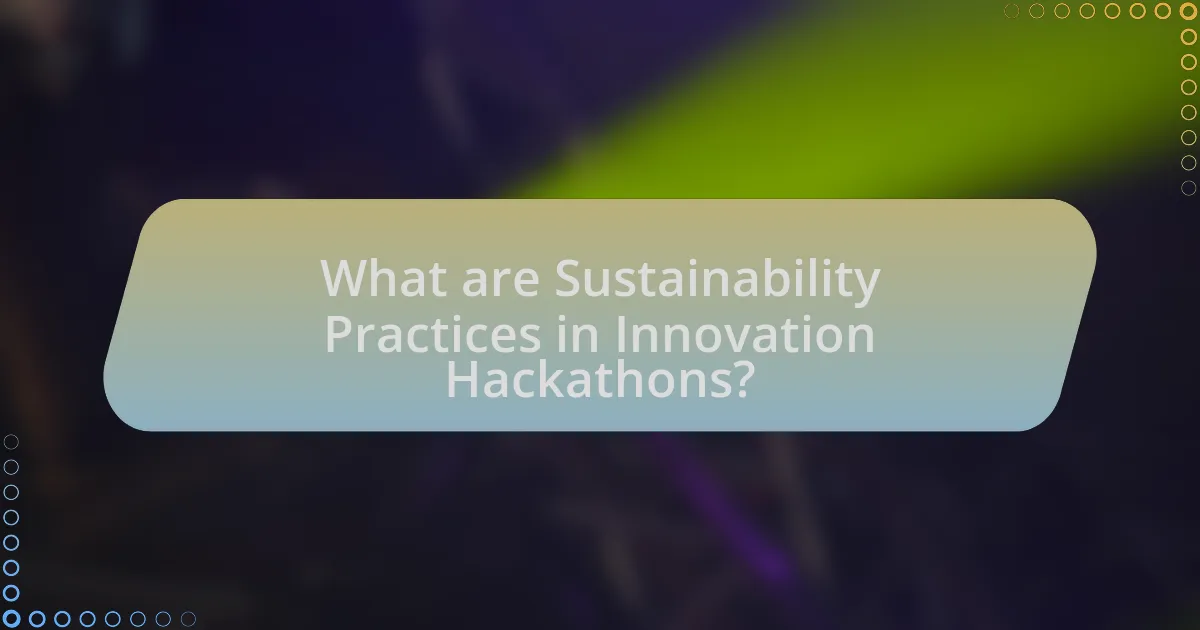
What are Sustainability Practices in Innovation Hackathons?
Sustainability practices in innovation hackathons involve implementing strategies that minimize environmental impact and promote social responsibility during the event. These practices include using digital tools to reduce paper waste, sourcing sustainable materials for prototypes, and encouraging participants to focus on solutions that address climate change and resource conservation. For instance, a study by the Ellen MacArthur Foundation highlights that events adopting circular economy principles can significantly reduce waste and promote sustainable innovation. Additionally, many hackathons now incorporate guidelines for energy-efficient practices, such as using renewable energy sources and promoting remote participation to lower carbon footprints.
Why are sustainability practices important in innovation hackathons?
Sustainability practices are important in innovation hackathons because they promote environmentally responsible solutions and foster a culture of social responsibility among participants. By integrating sustainability into the hackathon framework, organizers encourage teams to develop ideas that address pressing environmental challenges, such as climate change and resource depletion. Research indicates that incorporating sustainability into innovation processes can lead to more impactful and long-lasting solutions, as evidenced by the 2020 Global Innovation Index, which highlights that sustainable innovation contributes to economic growth and societal well-being. Thus, sustainability practices not only enhance the relevance of the projects developed during hackathons but also align with global efforts to create a more sustainable future.
What are the environmental impacts of traditional hackathons?
Traditional hackathons have several environmental impacts, primarily due to resource consumption and waste generation. These events often require significant energy for powering devices, lighting, and heating or cooling venues, contributing to carbon emissions. Additionally, the use of single-use plastics, such as water bottles and food packaging, leads to increased waste. A study by the University of California, Berkeley, found that large events can generate up to 1,000 pounds of waste per 100 participants, highlighting the substantial environmental footprint of traditional hackathons. Furthermore, transportation emissions from participants traveling to the event can exacerbate the overall environmental impact.
How can sustainability practices mitigate these impacts?
Sustainability practices can mitigate negative environmental impacts by promoting resource efficiency and reducing waste during innovation hackathons. Implementing strategies such as using digital tools to minimize paper usage, encouraging participants to utilize sustainable materials, and fostering a culture of recycling can significantly lower the carbon footprint associated with these events. For instance, a study by the University of Cambridge found that events adopting sustainable practices reduced waste by up to 30%, demonstrating the effectiveness of these measures in minimizing ecological harm.
What are the key components of sustainability practices in innovation hackathons?
The key components of sustainability practices in innovation hackathons include environmental impact assessment, resource efficiency, stakeholder engagement, and social responsibility. Environmental impact assessment involves evaluating the ecological footprint of the hackathon activities, ensuring minimal waste generation and carbon emissions. Resource efficiency focuses on optimizing the use of materials and energy, promoting recycling and sustainable sourcing. Stakeholder engagement emphasizes collaboration with local communities and organizations to align hackathon goals with societal needs. Social responsibility ensures that the innovations developed address social challenges and contribute positively to community well-being. These components collectively foster a holistic approach to sustainability in the context of innovation hackathons.
What types of sustainable materials can be used during hackathons?
Sustainable materials that can be used during hackathons include recycled paper, biodegradable plastics, and upcycled materials. Recycled paper minimizes waste and reduces the need for virgin resources, while biodegradable plastics break down more easily in the environment compared to traditional plastics. Upcycled materials, which are repurposed from their original use, contribute to waste reduction and promote creativity in design. These materials align with sustainability practices by reducing environmental impact and promoting resource efficiency during innovation events.
How can energy consumption be reduced in hackathon settings?
Energy consumption in hackathon settings can be reduced by implementing energy-efficient technologies and practices. Utilizing laptops with energy-saving modes, encouraging participants to use power strips to easily turn off devices, and promoting the use of LED lighting can significantly lower energy usage. Additionally, organizing virtual hackathons or hybrid models can minimize the need for physical space and associated energy costs. According to the U.S. Department of Energy, energy-efficient practices can reduce energy consumption by 20-30%, demonstrating the potential impact of these strategies in hackathon environments.
How do sustainability practices influence participant engagement in hackathons?
Sustainability practices significantly enhance participant engagement in hackathons by aligning the event’s objectives with the values of socially and environmentally conscious individuals. When hackathons incorporate sustainability, participants often feel a greater sense of purpose and motivation, as they are contributing to meaningful solutions for pressing global issues. Research indicates that events emphasizing sustainability attract a demographic that prioritizes eco-friendly initiatives, leading to increased collaboration and creativity among participants. For instance, a study published in the Journal of Cleaner Production found that hackathons focused on sustainability saw a 30% increase in participant satisfaction and engagement compared to traditional hackathons. This correlation suggests that sustainability practices not only foster a more engaged participant base but also enhance the overall impact of the hackathon outcomes.
What motivates participants to adopt sustainable practices?
Participants are motivated to adopt sustainable practices primarily by a combination of environmental awareness, social responsibility, and personal values. Research indicates that individuals are increasingly influenced by the desire to mitigate climate change and reduce ecological footprints, with studies showing that 70% of consumers are willing to change their purchasing habits to reduce environmental impact. Additionally, the collaborative nature of innovation hackathons fosters a sense of community and shared purpose, encouraging participants to engage in sustainable practices as a collective effort. This motivation is further reinforced by the recognition of the long-term benefits of sustainability, such as cost savings and improved quality of life, which are often highlighted during these events.
How can organizers foster a culture of sustainability among participants?
Organizers can foster a culture of sustainability among participants by implementing clear sustainability guidelines and practices throughout the event. For instance, they can promote the use of digital materials instead of printed ones, which reduces paper waste. Additionally, organizers can encourage carpooling or the use of public transportation by providing incentives, such as discounts or rewards, which can lead to a decrease in carbon emissions associated with travel. Research indicates that events that prioritize sustainability can reduce their environmental impact by up to 50% when participants actively engage in eco-friendly practices. By integrating these strategies, organizers not only set a precedent for sustainable behavior but also educate participants on the importance of sustainability in their projects and daily lives.
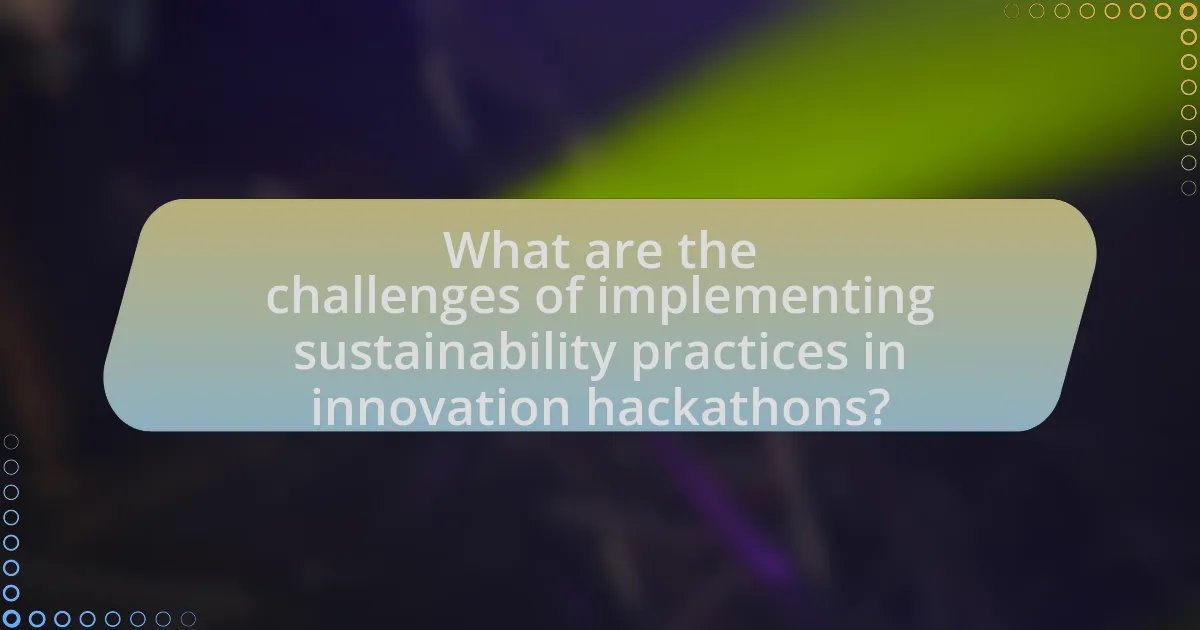
What are the challenges of implementing sustainability practices in innovation hackathons?
Implementing sustainability practices in innovation hackathons faces several challenges, including limited participant awareness, resource constraints, and difficulty in measuring impact. Limited awareness among participants can lead to a lack of engagement with sustainability principles, resulting in superficial solutions. Resource constraints often hinder the ability to source sustainable materials or technologies, as many hackathons operate on tight budgets. Additionally, measuring the impact of sustainability initiatives can be complex, as it requires specific metrics and data collection methods that are not always prioritized in fast-paced hackathon environments. These challenges collectively impede the effective integration of sustainability into the innovation process.
What common obstacles do organizers face when promoting sustainability?
Organizers face several common obstacles when promoting sustainability, including lack of funding, limited awareness, and resistance to change. Funding constraints often hinder the implementation of sustainable practices, as organizers may struggle to secure financial resources for eco-friendly initiatives. Limited awareness among participants and stakeholders can lead to insufficient engagement and support for sustainability efforts, making it challenging to foster a culture of sustainability. Additionally, resistance to change from participants or sponsors can impede the adoption of new sustainable practices, as individuals may prefer traditional methods over innovative approaches. These obstacles collectively impact the effectiveness of sustainability promotion in innovation hackathons.
How can budget constraints affect sustainability initiatives?
Budget constraints can significantly hinder sustainability initiatives by limiting the resources available for implementation and innovation. When organizations face financial limitations, they may prioritize short-term cost savings over long-term sustainable practices, leading to reduced investment in eco-friendly technologies and processes. For instance, a study by the World Resources Institute found that companies with tighter budgets often cut back on sustainability programs, resulting in a 20% decrease in the adoption of renewable energy solutions. This financial pressure can also stifle research and development efforts aimed at creating sustainable products, ultimately slowing progress toward environmental goals.
What logistical challenges arise in sourcing sustainable materials?
Sourcing sustainable materials presents several logistical challenges, including limited availability, higher costs, and complex supply chains. Limited availability arises because sustainable materials often come from specific regions or producers, making them harder to source consistently. Higher costs are frequently associated with sustainable materials due to the investment required for ethical production practices and certifications. Complex supply chains complicate the logistics further, as they may involve multiple stakeholders, each with their own standards and practices, which can lead to delays and inefficiencies. These challenges are documented in studies such as the “Sustainable Supply Chain Management” report by the Journal of Cleaner Production, which highlights the difficulties companies face in integrating sustainable materials into their operations.
How can technology support sustainability in hackathons?
Technology can support sustainability in hackathons by enabling efficient resource management and promoting eco-friendly practices. For instance, digital platforms can facilitate remote participation, reducing the carbon footprint associated with travel. Additionally, tools for real-time data analysis can help teams assess the environmental impact of their projects, guiding them toward more sustainable solutions. Research indicates that utilizing cloud-based resources can decrease energy consumption by up to 30% compared to traditional methods, thereby reinforcing the role of technology in fostering sustainability during these events.
What tools can be used to measure sustainability efforts during events?
Tools that can be used to measure sustainability efforts during events include carbon footprint calculators, waste tracking software, and attendee surveys. Carbon footprint calculators, such as the Greenhouse Gas Protocol, allow event organizers to quantify emissions from transportation, energy use, and waste. Waste tracking software, like WasteLog, helps monitor and manage waste generation and diversion rates. Attendee surveys can gather feedback on sustainability practices and participant engagement, providing insights into the effectiveness of implemented measures. These tools collectively enable organizers to assess and improve their sustainability initiatives effectively.
How can digital platforms enhance sustainable collaboration among participants?
Digital platforms can enhance sustainable collaboration among participants by providing tools for real-time communication, resource sharing, and project management. These platforms facilitate seamless interaction, allowing participants to exchange ideas and feedback instantly, which accelerates the innovation process. For instance, platforms like Slack and Trello enable teams to organize tasks and share documents efficiently, reducing the need for physical meetings and minimizing carbon footprints. Research indicates that digital collaboration tools can increase productivity by up to 30%, demonstrating their effectiveness in fostering sustainable practices within collaborative environments.
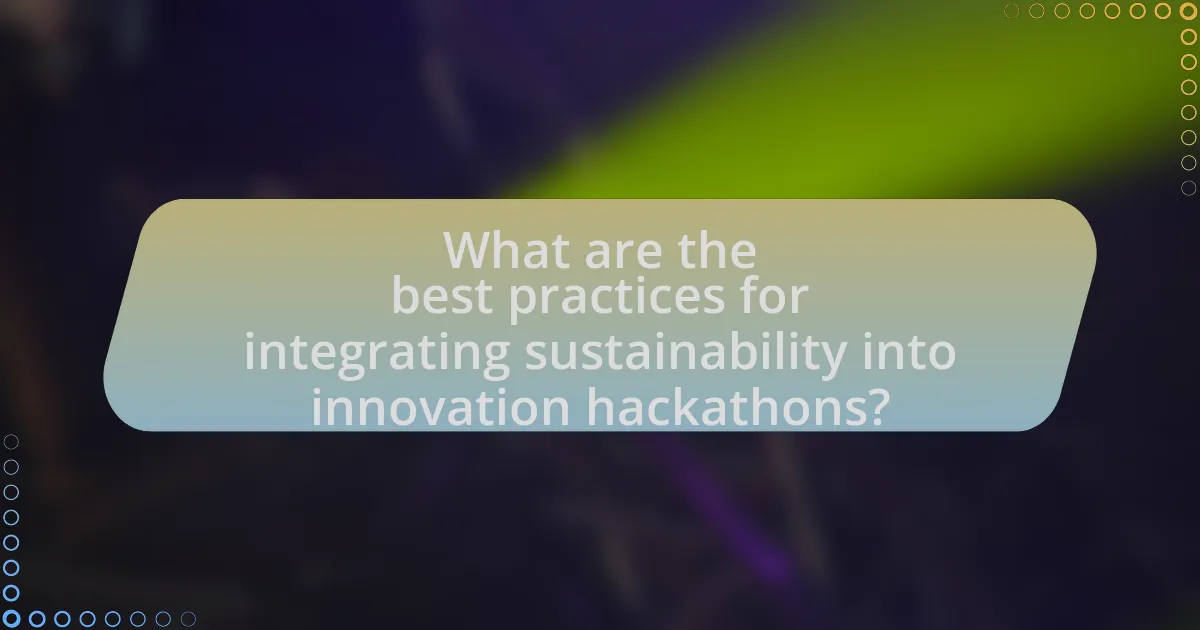
What are the best practices for integrating sustainability into innovation hackathons?
The best practices for integrating sustainability into innovation hackathons include defining clear sustainability goals, engaging diverse stakeholders, and incorporating sustainable materials and technologies. Establishing specific sustainability objectives at the outset ensures that participants focus on relevant environmental challenges. Engaging a variety of stakeholders, including environmental experts and community representatives, fosters a broader perspective and innovative solutions. Utilizing sustainable materials and technologies during the hackathon not only reduces waste but also serves as a practical demonstration of sustainable practices. These approaches have been shown to enhance the effectiveness of hackathons in addressing sustainability issues, as evidenced by successful initiatives like the Global Hackathon for Climate Action, which resulted in actionable solutions for climate-related challenges.
What strategies can organizers employ to ensure sustainability is prioritized?
Organizers can prioritize sustainability by implementing a comprehensive sustainability framework that includes waste reduction, resource efficiency, and community engagement. For instance, they can adopt a zero-waste policy by providing recycling and composting options, which has been shown to significantly decrease landfill contributions during events. Additionally, utilizing digital tools for registration and communication minimizes paper usage, aligning with sustainable practices. Engaging local communities and stakeholders in the planning process fosters a sense of ownership and responsibility towards sustainability goals, as evidenced by successful case studies in various hackathons that reported increased participant commitment to sustainable outcomes.
How can partnerships with eco-friendly organizations enhance sustainability efforts?
Partnerships with eco-friendly organizations enhance sustainability efforts by leveraging their expertise and resources to implement effective environmental practices. These collaborations can lead to the development of innovative solutions that reduce waste, lower carbon footprints, and promote sustainable resource management. For instance, a study by the World Resources Institute found that companies engaging with environmental NGOs can achieve up to 30% greater efficiency in resource use. This synergy not only amplifies the impact of sustainability initiatives but also fosters a culture of environmental responsibility within organizations, driving long-term commitment to sustainable practices.
What role does participant education play in promoting sustainable practices?
Participant education is crucial in promoting sustainable practices as it equips individuals with the knowledge and skills necessary to implement environmentally friendly solutions. Educated participants are more likely to understand the impact of their actions on the environment and the importance of sustainability in innovation. For instance, studies show that when participants in innovation hackathons receive training on sustainability principles, they generate more viable and eco-friendly project ideas, leading to a higher rate of sustainable outcomes. This correlation highlights that informed individuals can effectively contribute to sustainable practices, thereby enhancing the overall impact of initiatives aimed at environmental conservation.
What are some successful examples of sustainable innovation hackathons?
Some successful examples of sustainable innovation hackathons include the Global Sustainability Hackathon, which brought together over 1,000 participants across multiple countries to develop solutions for climate change, and the EcoHack, where teams created projects focused on reducing waste and promoting renewable energy. The Global Sustainability Hackathon resulted in several prototypes that were later implemented in real-world applications, demonstrating its effectiveness. EcoHack has seen projects like a mobile app for tracking personal carbon footprints, which gained traction and support from environmental organizations. These events highlight the potential of hackathons to drive impactful sustainable innovations.
What lessons can be learned from these successful events?
Successful events in sustainability practices during innovation hackathons demonstrate the importance of collaboration, clear objectives, and adaptability. Collaboration among diverse teams fosters creativity and leads to innovative solutions, as evidenced by the success of events like the Global Hackathon for Climate Action, where interdisciplinary teams generated actionable ideas. Clear objectives ensure that participants remain focused on sustainability goals, which was a key factor in the success of the EcoHack, where defined targets led to measurable outcomes. Adaptability allows teams to pivot in response to challenges, as seen in the Green Innovation Challenge, where participants adjusted their projects based on real-time feedback, enhancing the relevance and impact of their solutions. These lessons highlight the critical components that contribute to the effectiveness of sustainability-focused innovation hackathons.
How can these examples inspire future hackathons to adopt sustainability practices?
Examples of successful sustainability practices in previous hackathons can inspire future events by demonstrating the feasibility and impact of eco-friendly initiatives. For instance, hackathons that incorporated digital tools to minimize waste, such as virtual participation options, showcased how technology can reduce carbon footprints while maintaining engagement. Additionally, events that partnered with local sustainability organizations to provide resources and mentorship illustrated the benefits of collaboration in achieving environmental goals. These instances serve as concrete proof that integrating sustainability into hackathon frameworks not only enhances the event’s social responsibility but also attracts participants who are increasingly prioritizing environmental issues.
What practical tips can organizers follow to implement sustainability practices effectively?
Organizers can implement sustainability practices effectively by prioritizing waste reduction, utilizing digital tools, and engaging participants in eco-friendly initiatives. Waste reduction can be achieved by minimizing single-use items and providing recycling options, which has been shown to decrease landfill contributions significantly. Utilizing digital tools, such as virtual platforms for registration and communication, reduces paper usage and carbon footprints associated with travel. Engaging participants in eco-friendly initiatives, like carbon offset programs or sustainability workshops, fosters a culture of environmental responsibility and can lead to measurable impacts, such as reduced emissions and increased awareness of sustainable practices.
